Even as the Argentine government was announcing the biggest slide in the countryeconomic output in nearly a decade, technology investors in the nationcapital are all gearing up for record fundraising years.
Three of the countrybiggest firms (which are still small by international standards) are raising new, exponentially larger, funds in a sign that technology companies are showing promise despite the bleak picture painted by the broader economy in Latin America.
Leading the pack is NXTP Labs, the early stage investor thatdeveloping a regional network of accelerators and seed investment funds through partnerships that extend from Mexico City to Montevideo and Sao Paulo up to San Francisco. Despite its regional reach, home for NXTP is Buenos Aires and itthere that the firm began accelerating and investing in early stage companies back in 2011.
NXTP has already had 13 exits, according to Crunchbase, and is perhaps the most mature of the crop of investment firms in the country. Italso looking to be among the largest as it capitalizes on that trackrecord of exists and a portfolio of investments that has raised follow-on capital of nearly half a billion dollars.
The firm is currently knocking on doors to raise $120 million, a significant step up from its previous $38.5 million investment vehicle.
NXTP Labs isn&t the only firm based in Argentina thatlooking to significantly expand its capital under management. Jaguar Ventures,a firm that invests in both Argentina and Mexico, andDraper Cygnus, an Argentine-focused, Buenos Aires-based investment firm has already raised roughly $30 million of the $60 million it has targeted for its new fund,
While Cygnus is very much focused on the early-stage Argentine opportunity (which makes sense given the track record of technology companies coming out of the country — and the capital behind the firm) both NXTP and Jaguar have more of a regional perspective. And Jaguar, too, is massively increasing the size of its fund.
While its first fund was only $10 million, the new one will be closer to $60 million, according to one person with knowledge of the firmplans.
Behind the surge of confidence in the regiontechnology fortunes, despite the economic turmoil that continues to roil the region, is a growing track record of valuable companies — all with a homebase in Latin Americalargest market.
And while Brazil remains the regionundisputed economic powerhouse, there&re growing numbers of tech giants coming from Mexico, Argentina, Colombia, and Chile, investors said.
As Gonzalo Costa, a co-founder of NXTP Labs wrote in an editorial for TechCrunch earlier this week:
For the first time, companies are raising rounds of $100 million plus. 99 (acquired by Didi Chuxing), Nubank and Rappi, have all raised mega rounds in the past two years. Others have raised large rounds, such as Selina and Movile, with $90 million-plus, or Auth0 (part of our portfolio), with $50 million rounds in 2018.But the increase in dollar amounts is not only driven by mega rounds. More than 30 transactions of $3 million or more happened in 2017, which is triple in amount of rounds of that figure when compared to 2016. This shows a market maturity not seen before.
Not only are companies attracting more capital, but entrepreneurs are launching companies across a dizzying array of technology verticals.
These are companies like NubiMetrics, which provides competitive analysis and data for marketplaces like MercadoLibre; or Satellogic, which is developing a network of satellites for earth observation (and raised $27 million last year); or Pago Rural, which provides financing options for farmers in Latin America (and is raising a $20 million round, according to sources).
Itclear that venture capital and tech in Argentina (and across Latin America) is having a moment. But with a broader base of local capital, itpossible that this moment could become a movement. And that would have a profound effect on economies around the world.

 17
17







 Cheers to @opera on its IPO day! #OperaIPO $OPRA pic.twitter.com/dYeHux7pvq
Cheers to @opera on its IPO day! #OperaIPO $OPRA pic.twitter.com/dYeHux7pvq